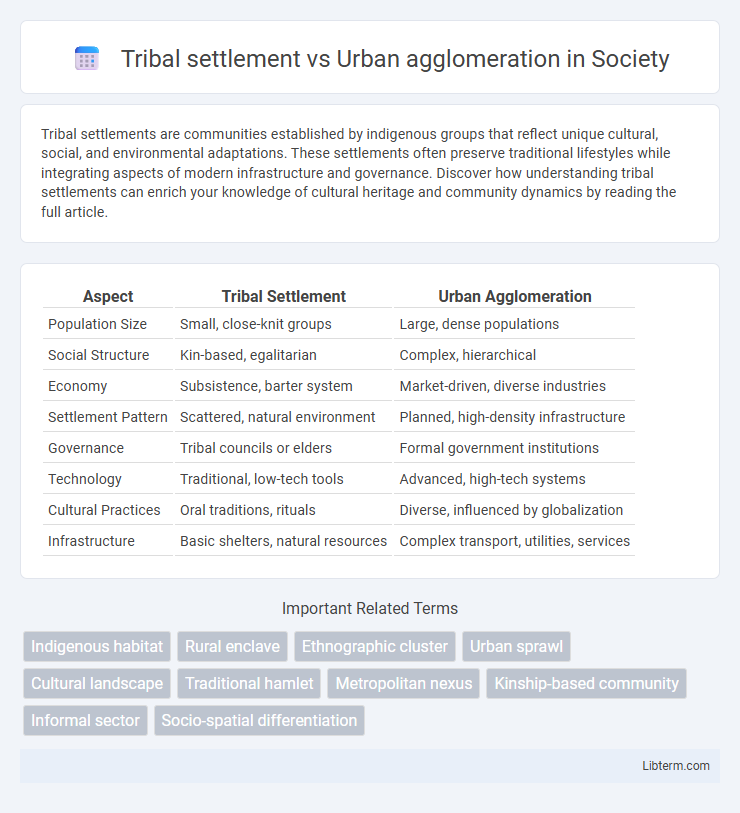Tribal settlements are communities established by indigenous groups that reflect unique cultural, social, and environmental adaptations. These settlements often preserve traditional lifestyles while integrating aspects of modern infrastructure and governance. Discover how understanding tribal settlements can enrich your knowledge of cultural heritage and community dynamics by reading the full article.
Table of Comparison
| Aspect | Tribal Settlement | Urban Agglomeration |
|---|---|---|
| Population Size | Small, close-knit groups | Large, dense populations |
| Social Structure | Kin-based, egalitarian | Complex, hierarchical |
| Economy | Subsistence, barter system | Market-driven, diverse industries |
| Settlement Pattern | Scattered, natural environment | Planned, high-density infrastructure |
| Governance | Tribal councils or elders | Formal government institutions |
| Technology | Traditional, low-tech tools | Advanced, high-tech systems |
| Cultural Practices | Oral traditions, rituals | Diverse, influenced by globalization |
| Infrastructure | Basic shelters, natural resources | Complex transport, utilities, services |
Understanding Tribal Settlements: Definition and Characteristics
Tribal settlements are defined by their close-knit communities that maintain traditional customs, often located in rural or forested areas with a reliance on subsistence agriculture and natural resource management. These settlements exhibit unique social structures, kinship ties, and cultural practices distinct from urban environments. Unlike urban agglomerations, which are characterized by high population density and complex infrastructure, tribal settlements emphasize ecological balance and communal living.
Urban Agglomeration: Key Features and Dynamics
Urban agglomeration refers to a densely populated region consisting of a central city and its surrounding suburbs and towns, characterized by continuous urban spread and integrated economic functions. Key features include high population density, extensive transportation networks, and diverse economic activities ranging from industrial to service sectors. The dynamics of urban agglomeration involve rapid urbanization, spatial expansion, socio-economic interdependence, and significant infrastructural development to support the growing population and economic complexity.
Historical Context: Evolution of Tribal and Urban Communities
Tribal settlements historically emerged as small, kin-based groups relying on hunting, gathering, and rudimentary agriculture, reflecting a close relationship with natural environments and traditional governance structures. Urban agglomerations evolved through the consolidation of multiple settlements into complex, densely populated centers driven by economic trade, administrative functions, and technological advancements. The transformation from tribal to urban communities marked a shift from subsistence lifestyles to organized socio-political systems, enabling cultural exchange and technological innovation.
Population Density: Contrasts between Tribal and Urban Areas
Tribal settlements typically exhibit low population density, with families spread over large areas due to subsistence lifestyles and reliance on natural resources. Urban agglomerations, by contrast, have extremely high population density driven by industrialization, economic opportunities, and infrastructural development. This density contrast reflects differing land use patterns, social organization, and access to services in tribal versus urban environments.
Governance and Social Structure: Tribal Clans vs Urban Administration
Tribal settlements are governed by clan-based systems emphasizing kinship ties, customs, and collective decision-making, allowing for a decentralized social structure rooted in traditional authority. Urban agglomerations operate under formalized governance with structured administrative bodies, such as municipal corporations and elected officials, managing complex social functions through laws and policies. The contrast highlights tribal communities' reliance on interpersonal relationships and customary norms versus urban areas' dependence on institutionalized governance and bureaucratic frameworks.
Economic Activities: Subsistence vs Diversified Urban Economies
Tribal settlements primarily engage in subsistence economic activities such as hunting, gathering, and small-scale agriculture focused on meeting local needs. Urban agglomerations host diversified urban economies characterized by industrial production, service sectors, trade, and technological innovation that drive regional and global markets. This economic complexity in urban areas facilitates higher income generation, employment variety, and infrastructure development compared to the largely self-sufficient and resource-dependent tribal economies.
Infrastructure and Development: Services in Tribal vs Urban Settings
Tribal settlements often face limited infrastructure and basic service provision, with challenges in access to clean water, healthcare, and education due to remote locations and traditional governance structures. Urban agglomerations benefit from extensive infrastructure development, including advanced transportation networks, hospitals, schools, and utilities that support dense populations and diverse economic activities. The disparity in service availability drives migration from tribal areas to cities, impacting social dynamics and resource allocation.
Cultural Heritage and Identity Preservation
Tribal settlements sustain cultural heritage through traditional practices, languages, and rituals deeply rooted in ancestral lands, fostering a strong sense of identity tied to their environment. Urban agglomerations, characterized by diverse populations and rapid modernization, often face challenges in preserving unique cultural identities amidst globalization and infrastructural expansion. Effective preservation in urban settings requires intentional cultural policies and community initiatives that protect indigenous heritage within increasingly complex metropolitan areas.
Environmental Impact: Land Use in Tribal and Urban Regions
Tribal settlements typically feature low-density land use, preserving natural vegetation and biodiversity through traditional practices that support ecological balance. Urban agglomerations exhibit high-density land use with extensive infrastructure development, leading to habitat fragmentation, increased pollution, and significant alteration of natural landscapes. The environmental impact in urban areas is intensified by expanded impervious surfaces causing runoff and heat island effects, contrasting sharply with the sustainable land management in tribal regions.
Challenges and Opportunities: Future of Tribal and Urban Coexistence
Tribal settlements face challenges like limited infrastructure, restricted access to education, and cultural preservation pressures, while urban agglomerations grapple with overcrowding, pollution, and social inequality. Opportunities exist in integrating sustainable development practices, promoting inclusive policies, and leveraging technology to enhance resource management and connectivity for both communities. The future of tribal and urban coexistence depends on collaborative governance, equitable economic opportunities, and culturally sensitive urban planning that respects tribal heritage.
Tribal settlement Infographic

 libterm.com
libterm.com